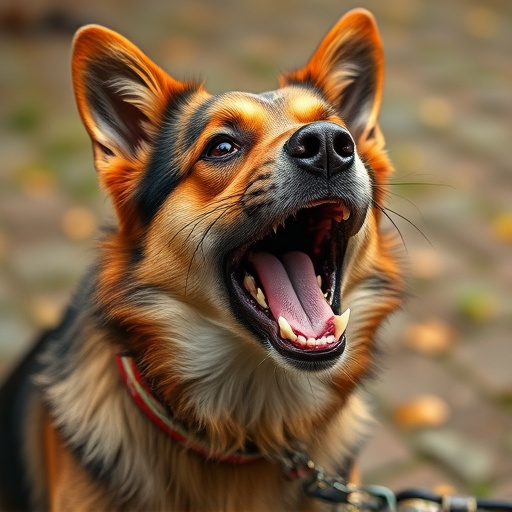Dog pepper spray exposure occurs when canines come into contact with human pepper spray during altercations or as a defense mechanism. Symptoms range from excessive panting and drooling to eye and nose irritation, difficulty breathing, and severe cases may include seizures or loss of consciousness. Prompt action is crucial; washing the affected area with water and providing oxygen if needed can help alleviate symptoms. Immediate veterinary care should be sought for persistent or severe reactions to effectively treat dog pepper spray exposure and prevent long-term health issues. Preventive measures include education, desensitization walks, protective gear, and basic command training.
“Protecting your pet from unexpected hazards is every owner’s priority. In this comprehensive guide, we delve into the critical topic of dog pepper spray exposure—a potentially severe issue that requires swift and effective action. Understanding the causes and symptoms is the first step. We’ll navigate through immediate response strategies and detailed treatment methods for inhalation. Additionally, discover proactive safety measures to prevent future incidents, ensuring your furry companion’s well-being. Learn how to treat dog pepper spray exposure with our expert advice.”
- Understanding Dog Pepper Spray Exposure: Causes and Symptoms
- Immediate Steps to Take After Dog is Exposed to Pepper Spray
- Effective Treatment Methods for Dog Pepper Spray Inhalation
- Preventing Future Incidents: Safety Measures for Dog Owners
Understanding Dog Pepper Spray Exposure: Causes and Symptoms
Dog pepper spray exposure can occur when a canine comes into contact with mace or similar irritants designed for human use, often during altercations or attempts to protect themselves from perceived threats. Understanding how and why this happens is crucial in knowing how to treat dog pepper spray exposure. Causes range from direct spraying to indirect contact through contaminated surfaces, with symptoms varying based on the amount of exposure.
Common signs include excessive panting, drooling, tear production, irritation or redness in the eyes and nose, difficulty breathing, agitation, and hiding or seeking shelter. Severe cases may result in seizures or even loss of consciousness. Prompt action is essential when dealing with suspected pepper spray exposure. Washing the affected area with plenty of water, along with administering oxygen if respiratory distress is present, can help alleviate symptoms. Seek veterinary care immediately for persistent or severe reactions to ensure effective how to treat dog pepper spray exposure and prevent potential long-term health issues.
Immediate Steps to Take After Dog is Exposed to Pepper Spray
If your dog has been exposed to pepper spray, it’s crucial to act quickly to mitigate any potential harm. The first step is to remove your dog from the area where the exposure occurred as soon as possible. Pepper spray can cause irritation and inflammation in a dog’s eyes, nose, and respiratory system, so moving them to a fresh, well-ventilated space is essential. Rinse their face gently with water for at least 15 minutes; this will help to dilute and flush out any remaining pepper spray residue.
After the initial rinse, consider using a mild, dog-safe shampoo to clean their fur, focusing on areas affected by the spray. Ensure you thoroughly rinse again afterward. If your dog is experiencing difficulty breathing or has severe reactions, contact your veterinarian immediately. They may recommend further treatment, such as an inhalant or topical medication, to soothe and protect your pet’s delicate systems from the effects of pepper spray exposure.
Effective Treatment Methods for Dog Pepper Spray Inhalation
If your dog has been exposed to mace spray, it’s crucial to act quickly and effectively. The first step in how to treat dog pepper spray exposure is to move your pet to a fresh, well-ventilated area immediately. Pepper spray irritates the respiratory system, so any action that improves airflow is beneficial. Rinse your dog’s face gently with warm water to help flush out any residual spray. Avoid using soap as it can irritate the skin further.
After initial flushing, monitor your dog for symptoms of exposure, such as coughing, panting, or difficulty breathing. If these persist, contact a veterinarian promptly. Treatment may involve administering oxygen, bronchodilators, or other medications to ease respiratory distress. It’s also important to keep your dog calm and warm during recovery, offering small sips of water if they can breathe comfortably.
Preventing Future Incidents: Safety Measures for Dog Owners
Dog owners must take proactive steps to prevent future incidents involving dog pepper spray exposure, especially considering the severity of its effects. The first line of defense is educating oneself and one’s canine companion about potential triggers. Regularly walking dogs in areas where pepper spray residue might linger can desensitize them to the scent over time, reducing the likelihood of an accidental encounter.
Moreover, owners should invest in high-quality protective gear, such as specialized goggles and respirators designed for pets. Keeping these items readily available during walks can facilitate swift response in case of exposure. Additionally, teaching dogs basic commands like “stay” or “leave it” enhances control, enabling owners to take immediate action if pepper spray is used nearby.
Knowing how to treat dog pepper spray exposure is crucial for responsible pet ownership. By understanding the causes and symptoms, taking immediate action after exposure, and implementing preventive safety measures, you can ensure your dog’s well-being and avoid future incidents. Remember, quick response and proper treatment are key in mitigating the effects of pepper spray on your canine companion.
